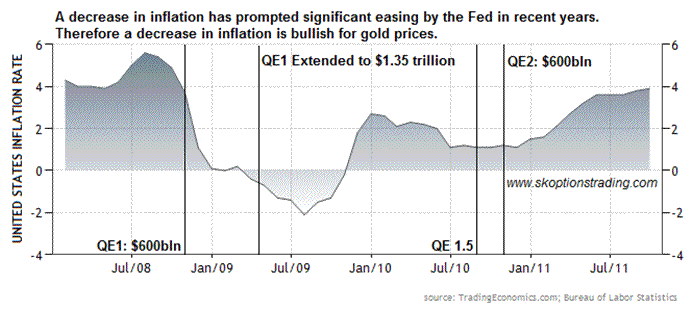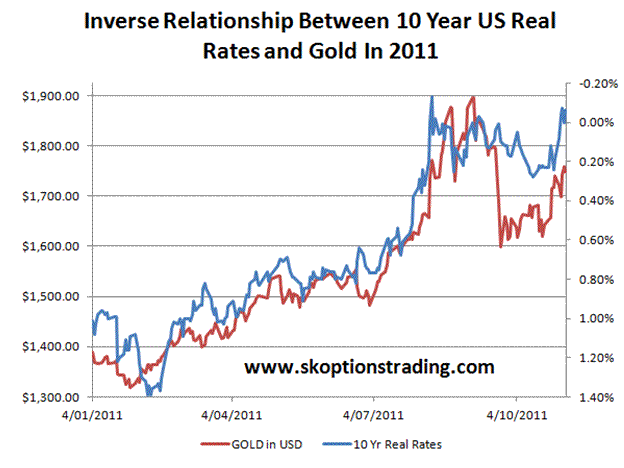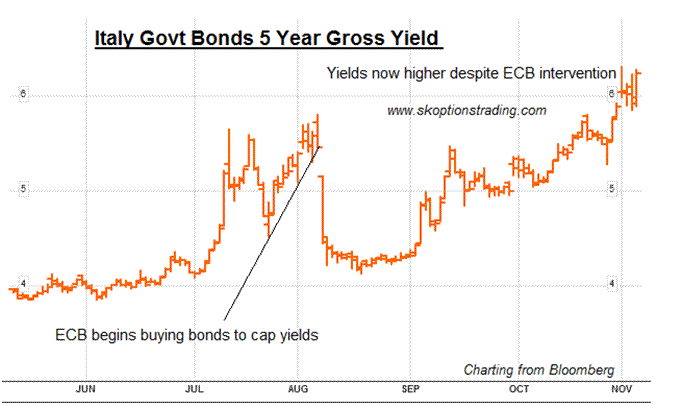Falling Inflation, The Most Bullish Sign For Gold
Commodities / Gold and Silver 2011 Nov 07, 2011 - 04:20 AM GMTBy: Bob_Kirtley
 Whilst many may argue that gold is an inflation hedge and therefore inflation is bullish for gold, in reality the dynamics at play here are not that simple.
Whilst many may argue that gold is an inflation hedge and therefore inflation is bullish for gold, in reality the dynamics at play here are not that simple.
In our view, gold is a currency. Therefore fluctuations in its price are largely based on its perceived value relative to other currencies. We would not suggest that its role as an inflation hedge is a primary reason for being long gold, since there are far more direct and efficient ways to hedge against inflation risk in this modern financial environment. We do however see currency devaluation as a primary reason to own gold. If one thought the Yen was going to strengthen against the dollar, then one would move USD holdings into JPY. If one thought the Yen was going to weaken against sterling, then one move JPY holdings into GBP. This environment is unique as across the world governments and central banks are trying to lower the value of their currencies. Therefore there is nowhere to go, except for gold which cannot be printed in an attempt to erode its value.
The US Federal Reserve has a dual mandate to both maintain price stability and full employment. This means their job is to prevent deflation and keep inflation in a tolerable range, plus ensure that unemployment is not too high.
Clearly the employment side of this mandate is not being met at present, with the latest US payroll data showing unemployment still at 9%. However the one thing holding the Fed back from further easing is inflation. We can therefore deduce that a drop in inflation would be very bullish for gold prices, as it would increase market expectations of more large scale asset purchases (LSAPs) by the Federal Reserve.

Consequently a drop in CPI inflation would be the most bullish signal for gold that we could think of. A large increase in unemployment may also push the Fed to ease, but disinflation would carry more weight as the Fed is then failing on both its mandates. In our opinion the Fed fears deflation more than high unemployment. Whilst 9% unemployment is a situation that nobody wants, deflation carries far greater risks as it could lead to a deflationary spiral and depression. However persistently high unemployment is adding pressure for the Fed to ease and soon that pressure will become so large that the Fed has to ease. Nonetheless a drop in the inflation rate would massively increase market expectations for further easing, and therefore be tremendously bullish for gold prices.
We do not think any further easing from the Fed is due until 2012, but do think long positions in gold are warranted at this time as there is a significant chance that the market will begin increasing its expectations of easing over the coming months and therefore would drag gold prices higher.
US Real Interest Rates and Gold
In our opinion one of the main determinants of gold prices in the medium to long term is US real interest rates. US real rates are the rate of interest that can be earned on US Government bonds, minus the expected rate of inflation. One can monitor US real rates by watching the yields on Treasury Inflation Protected Securities (TIPS) and we watch them closely since they exhibit a negative relationship with gold.
The basic fundamentals behind this inverse relationship are that when US monetary policy is looser, real rates fall and therefore investors buy gold for a number of reasons which we have covered in previous articles.
Currently when we analyse where US real rates are in relation to gold prices, we come to the conclusion that gold prices are low in relation to US real rates.

Our model for analysing the relationship between gold and real interest rates suggest that gold prices should be significantly higher than $1800.00/oz, given the current level of US real interest rates. Of course no model is perfect and even if it was it doesn’t mean that gold prices must rise, as real interest rates could increase and the relationship would remain intact. However if the US does embark on further monetary easing, or market expectations of easing increase then US real interest rates could fall still further, implying an even higher gold price.
Eurozone
During the last month, stocks and most other risk assets have rallied significantly. Fears over Europe have subsided somewhat and the many parts of the market indicated a brighter future ahead. Although there are many positive signs, we think there are some seriously negative signs coming from the European sovereign debt market.
These troubling signs are in Italy and in Spain and should not go unnoticed and are much more significant that Greece. For example the estimated cost to Germany of bailing out Greece, Ireland and Portugal entirely in the wake of the default of those countries would be a little over EUR1,000 per person, in a single hit. Italy is a totally different situation, their mountains of debt dwarf that of the smaller nations.
Since the end of September Italian and Spanish yields have been moving higher, despite the ECB bond buying programme in an attempt to keep a lid on interest rates. This week we saw the ECB cut interest rates by 25bps but not only did that not solve the problem, it actually revealed (or perhaps confirmed) an even larger problem.
Italian Government 5 Year bonds were trading at the beginning of this week around 5.73%. Just before the ECB unexpectedly cut interest rates by 25bps, the bonds were trading at 6.13% and then fell to 5.82%, which is a drop of 31bps. However these levels could not be held and the bonds sold off to 6.19% once the initially rate cut induced buying had subsided.
This is a cause for concern as it implies that Italian Government debt is no longer an interest rate instrument, but more of a credit based instrument. This means that the ECB can no longer help Italy with interest rate cuts, because no amount of cuts of short term lending rates can remove the real credit risk that accompanies Italian debt. Interest rate cuts may help countries such as Germany and France as their government bonds still trade in line with interest rate expectations, but it is not helpful for Italy any more.

We witnessed a similar scenario with Greece, Portugal and Ireland. When the credit risk is the driving factor behind the market, fluctuations in short term interest rates have little impact. Whilst they may work for nations like Germany, that doesn’t really help the situation as Germany does not have a debt problem and the yield on 2 year German government bonds is only 0.4% at present.
So what can the ECB do?
Now that Italy is immune to interest rate cuts, the ECB has very few options. It can step back and leave the politicians to deal with the crisis, but we doubt that this course of action has much chance of a happy ending. We seriously doubt the capacity for Italy to form, pass and implement a credible austerity plan that would calm the markets and lower yields. Recently Italy announced that they had a plan to make a plan to tackle the issue, which consisted of increasing the retirement age by two years by the year 2026 and raising a measly €5 billion from privatisations. This calibre of plan is not even close to being acceptable by the markets.
Therefore we think the ECB has little choice but to directly intervene in the Italian debt markets as they did in early August. If the new (Italian) head of the ECB really wants to get a control of this situation before it gets out of hand then the announcement of large scale purchases of Italian debt appears to be the only credible option. There is little benefit from cutting interest rates again from here. Direct intervention and large scale asset purchases by the ECB will need to come from printing more Euros, a form of monetary easing that is bullish for gold prices.
Sophisticated investors may wish to consider being long gold and short Italian government bonds. If the ECB turns on the printing presses to stop Italy falling off a cliff, then gold prices will benefit massively. However in all likelihood the best the ECB could do would be to cap yields, they can’t drive yields into the floor as the underlying credit issues are still there. If they don’t print to save Italy, then it is likely that Italian government bond yields will continue to rise and thus a short position is warranted. Gold should remain supported under this scenario due to safe haven buying. We feel this is a compelling pair trade.
This could be done directly via physical or futures, or even via ETNs with short positions in ITLT (PowerShares DB 3x Italian Treasury Bond Futures ETN) or ITLY (PowerShares DB Italian Treasury Bond Futures ETN) paired with long positions in GLD or DGP.
Trading Strategy
We think that long positions on gold are warranted in the current environment, given the high chance of further monetary easing in the US, Europe or even in both. We continue to avoid gold mining companies and still do not view them as a suitable gold investment vehicle. We also maintain that shorting the gold mining stocks against being long gold is a decent pair trade (YTD the HUI index is up 3% gold is up 23%, so this pair trade has returned 20% in 2011). Short positions on Italian debt and long positions on gold appear to be good trades going forward. To find out what option trades we are recommending to our subscribers one can sign up to our premium options trading service, SK OptionTrader. Subscribers receive market updates and trading signals via email, along with a model portfolio with suggested capital allocations accompanying each trade. A detailed list of all closed trading recommendations can be found on our website: www.skoptionstrading.com.
To stay updated on our market commentary, which gold stocks we are buying and why, please subscribe to The Gold Prices Newsletter, completely FREE of charge. Simply click here and enter your email address. (Winners of the GoldDrivers Stock Picking Competition 2007)
For those readers who are also interested in the silver bull market that is currently unfolding, you may want to subscribe to our Free Silver Prices Newsletter.
DISCLAIMER : Gold Prices makes no guarantee or warranty on the accuracy or completeness of the data provided on this site. Nothing contained herein is intended or shall be deemed to be investment advice, implied or otherwise. This website represents our views and nothing more than that. Always consult your registered advisor to assist you with your investments. We accept no liability for any loss arising from the use of the data contained on this website. We may or may not hold a position in these securities at any given time and reserve the right to buy and sell as we think fit. Bob Kirtley Archive |
© 2005-2022 http://www.MarketOracle.co.uk - The Market Oracle is a FREE Daily Financial Markets Analysis & Forecasting online publication.



